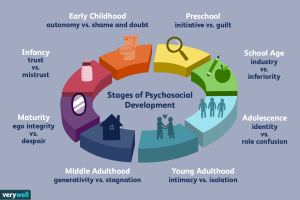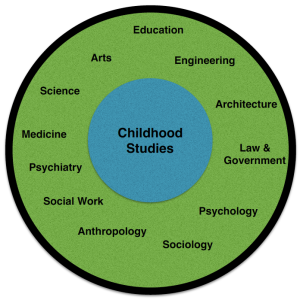1
Learning Objectives
In this chapter, you will
- Appraise the historical and contemporary definitions of childhood.
- Brainstorm issues concerned with the well-being of children.
What is Childhood Studies?
Key Takeaway
James and James (2012) define Childhood Studies as the interdisciplinary study of the early period of the human life course that is legally recognized, socially, and scientifically defined as childhood, as distinct from adulthood (p. 18).
The UNCRC defines a child as a person under 18 years of age. It acknowledges the primary role of parents and the family in the care and protection of children, as well as the obligation of the State to help them carry out these duties.
Why study Childhood?
Would you agree that childhood experiences have a lifelong impact? I believe that childhood experiences build the foundation for learning and life. I studied Child Development as an undergraduate student. As a Child Development major, I learned how development occurs within the context of family, community, culture, and relationships as well as the interactions among developmental domains of the child and the role of environmental factors. I was able to use my understanding of child development in my work as a preschool teacher. I could identify, interpret, and respond to a child’s individual differences, needs, and challenges. I was able to provide resources to support families in giving children a positive start in life.
As you progress through this course, think about how your increased understanding of children will prepare you for possibly working with children and families.
Take a moment to:
- Complete these sentences
- Children should ….
- Children should not ….
Comparing Childhood to other stages of life
During our time together, you will learn more about the stage of life labeled childhood. Childhood is different and in some ways similar to other stages of life.
Developmentalists often break the lifespan into eight stages of development from Prenatal Development to Late Adulthood or maturity. The stages are illustrated below.

To learn more go to the chapter Human Development in the Lifespan Development text in the sidebar and scroll down to the section: Periods of Human Development.
How do you study childhood?
Understanding the concept of childhood is complex and must consider many influences and perspectives. An interdisciplinary approach is most beneficial.
What is an interdisciplinary approach? First, I need to define a discipline which is a branch of knowledge or an area of study that is taught and researched as part of higher education. The image below lists disciplines involved in the study of childhood.

What disciplines study children?
Different disciplines developed unique ways of approaching the study of children, using different research methods driven by research questions. For some disciplines (such as sociology and cultural studies) childhood as a concept is specifically addressed looking at childhood as a social construction and a variable of social analysis. They would study children’s relationships and cultures; and children as active social agents. A research method used by sociologists is ethnography.
In contrast, in other disciplines, such as psychology and education, the focus of research is on the child or children. I engaged in interdisciplinary research to study childhood with a registered architect. To see our work you can read the brief article: Seven Home Design Elements To Help Children Learn Language
Below is a chart to illustrate how disciplines can contribute to the understanding of childhood. Explore at the journals listed below, you have to scroll over to see the 4th column. The information was found on a comprehensive list at Rutgers. You can use journals that you are familiar with from previous courses or use the BSU Maxwell library to access the full text articles.
| Discipline | Focus | Example of contribution to Childhood Studies | Possible Journal to Investigate |
| Psychology | All aspects of children’s development from birth to adolescence; focusing on the period between birth and 18 years old. | Theories of Piaget and Vygotsky explain how children move through developmental stages and some moving faster or slower than others. | Developmental Psychology |
| Law | Defines child as anyone between the ages of 0 and 18. | Are/should children under the age of 18 years exempt from criminal liability? | Children’s Legal Rights Journal |
| Health/Biology | Biological or physical development of children (stages of growth). | How much physical activity do children need to maintain health and mobility? | Children’s Health Care |
| Social Work | Mental health & quality of life Human rights are at the heart of social work. | Helps children and families more effectively cope with the stresses of life and to deal with systemic problems such as child abuse and homelessness. | Child Abuse and Neglect |
| Sociology | The cultural view of child specific to time and place | A study about children’s rights and educational policy in Europe: The implementation of the United Nations Convention on the Rights of the Child. | British Journal of Sociology of Education |
| Education | Cognitive development of children or learning. | Could focus on topics such as curriculum, child care programs, administration, staff development, family-school relationships, equity issues, multicultural education, facilities, and special needs. | Childhood Education |
| Anthropology | Sees children as social actors in their own right and seeks to document their perspectives on, and participation in, the social world. They study different kinds of childhood in different societies. | Should childhood be seen as a cultural universal? | Children’s Geographies |
| History | Compares children’s lives as they were in the past paralleled to how children may live their lives in the modern day. | Children in the past worked at a younger age than is acceptable now. | Journal of the History of Childhood and Youth |
| English/Communication | Looks at the representation of children in media and literature. | Look at the history of children’s literature. How has the Cinderella story changed over time? | Red Feather Journal: |
| Philosophy | Concerned with understanding the nature of children. | Theories by Jean-Jacques Rosseau (1762) believed that children should be kept away from the corruption of adults and left to develop in a manner that would keep them good. Philosophy contrasts this view with the philosopher John Locke (1690) who saw children as being neither good nor bad believing that children’s behavior and personalities are molded by giving children strong discipline and education. | Questions: Philosophy for Young People |
| The Arts (visual, dance, music, & theater) | Focuses on the connection between arts participation and human development | The Importance of Art in Child Development | ArtsEdSearch |
An interdisciplinary approach is beneficial to understanding the lives of children and youth; because it enables researchers to gain information from different sources and compare the ways children are viewed, understood, and taken care of in different parts of the world. An interdisciplinary approach also enables us to look at and compare children’s lives in the modern-day and in the past, and to look at the way in which children are diverse and how these diversities affect the speed they move through the different stages of childhood development at different rates. Nissani (1997) lists several benefits of an interdisciplinary approach:
- Creativity is enhanced in an interdisciplinary study.
- Errors and assumptions are often detected when working with people from outside our discipline.
- By using an interdisciplinary approach we may bridge communication gaps helping to mobilize resources in the cause of greater social justice.
Interdisciplinarity combines two or more disciplines to a new level of integration suggesting component boundaries start to break down. Interdisciplinarity is no longer a simple addition of parts but the recognition that each discipline can affect the research output of the other.
To explore an interdisciplinary approach read the 2013 article Different Cultures, Different Childhoods where the author uses knowledge of anthropology and history to study children. Montgomery gives a brief overview of how the historical context and culture influence what is considered typical for a child. How might you describe an ideal childhood?
Now, view the 75-minute video Babies (2010) Bébé(s) (original title). BSU students can view the video on Blackboard. The PG-rated documentary focuses on four newborns, photographed in their natural habitat in distinctly different parts of the world. Hattie is in San Francisco, Mari’s in Tokyo, Baryarjargal lives out in the Mongolian steppes, and Ponijao is born amid the simple straw huts of Namibia. You will follow the babies through their first year of life. As you watch the video, you may want to complete the reading reflection form available on Blackboard as a way to take notes and organize your thinking.
After reading this chapter and completing the activities you should be able to answer
- What is childhood?
- How would you define “child” and “childhood”?
- How do time and place influence your definition?
- How is childhood different from other stages of life, and what does it share in common with them?
- When does childhood begin and end?
References
Balmès, T. (Director), & Chabat, A., Billot, A., & Rouxel, C. (Producers). (2010). Babies [Motion picture on DVD]. Universal Studios Home Entertainment.
Nissani, M. (1997). Ten cheers for interdisciplinarity: The case for interdisciplinary knowledge and research. Social Science Journal, 34(2), 201.
